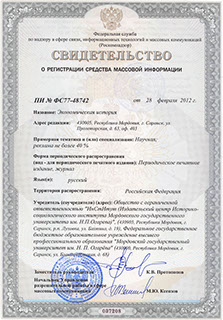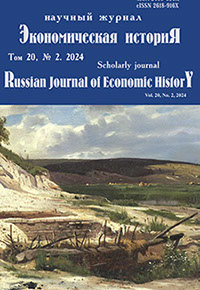Экономическая историЯ
Russian Journal of Economic History
ISSN 2409-630X (Print)
ISSN 2618-916X (Online)
Expert board:
- Scientific Council of RAS on economic history;
- Research and Educational Center «The economic history of Central Russia and the Middle Volga region» of Ogarev Mordovia State University;
- Center of Economic History of Lomonosov Moscow State University
Navigation
Certificate of registration

ISSN 2409-630X (Print), ISSN 2618-916X (Online)
DOI: 10.15507/2409-630X.065.020.202402.114-132
УДК 947.084.5
Roman R. Seitumerov
Ulyanovsk State Pedagogical University (Ulyanovsk, Russia),
e-mail: seytumerov@icloud.com
Monetary Reform 1922–1924: Regional Aspects
(on the Materials of the Simbirsk Province)
Abstract
Introduction. In the presented material, an attempt is made to analyze the main directions of the monetary reform of 1922–1924 in Soviet Russia and the USSR, to show both its strengths and the difficulties that manifested themselves most relief during the period of its implementation in the regions. It has been shown that the beginning of the monetary reform was preceded by a serious discussion among Russian economists dealing with the problems of monetary circulation and credit about the orientation, methods and possible consequences for the economy of monetary reform. The article on a wide archival basis analyzes the process of phased implementation of monetary reform in the Simbirsk province at the beginning of a New Economic Policy, shows the leading role of the Simbirsk branch of the State Bank in its implementation, which acted in full cooperation with the financial management of the Simbirsk Provincial Executive committee.
Materials and Methods. Among the methods of special-historical research we use can be called the updating method, expressed in determining the value of certain historical knowledge (approaches, theories), which describes the role and place of the State Bank. The methods of logical and specific analysis allowed us to study historical and historiographic facts, taking into account the conditions of their appearance and the influence exerted on each other, which helped us to find in many ways the reasons that gave rise to them. The use of the historical and genetic method helped us to reveal the main directions of activity of the branches of the State Bank in the process of NEP’s transformations, to understand the cause and effect relationships when analyzing certain actions of the branch in the conditions of known historical events. The basis of the historical and comparative method we use is analogy. The expression in the same similar forms of the different content of the work of the State Bank in different historical conditions helped explain the existing scientific facts and reveal their essence.
Results. Success of a monetary reform of 1922–1924 was in many respects caused by the fact that issue of chervonets was made not thanks to printing new money, and by means of effective financing of the industry, credit institutions from the State Bank, to successful development of the state trade. And, the National bank sharp-sightedly watched a condition of the market, stopping delivery of the new credits in cases when the market slowed down the development or was in a condition of stagnation. In general, results of a monetary reform of 1922–1924 turned out positive in what there was a considerable contribution of offices of National bank. Gradually, confidence in state monetary circulation returned to the population, in taxation finally in 1924–1925 passed to monetary form. In the country, its regions, trade has revived, the whole set of commodity-monetary relations, and the population of the country has an incentive to make money in order to improve its financial situation, the inflation rate in the country has noticeably decreased.
Discussion and Conclusion. After the transition to a New Economic Policy, a crisis of monetary circulation broke out in the country, which had to be resolved as soon as possible, otherwise the progressive development of the Soviet economy and the restoration of the national economy destroyed by the war would be a big question. Any economic transformation was almost impossible without the implementation of monetary reform, since the landslide depreciation of the ruble – the scoop prevented the reconstruction of commodity and money markets in the country. The state Bank managed to achieve a stable purchasing power of new money and the ratio with gold and foreign currency corresponding to the gold content, which was achieved by immediately paying at the cash desk of the State Bank increasing in volume and unchanged in terms of the purchasing amount of notes, establishing control over all credit and financial operations.
Keywords: banks, credit and financial regulation, currency, chervonets, soviet monetary token (token), financial commissions.
For citation: Seitumerov R. R. Monetary Reform 1922–1924: Regional Aspects (on the Materials of the Simbirsk province). Ekonomicheskaya istoriya = Russian Journal of Economic History. 2024; 20(2): 114–132. (In Russ.). DOI: 10.15507/2409-630X.065.020.202402.114-132.
© Ogarev Mordovia State University. History and Sociology Institute, 2017
68, Of. 411, Bolshevistskaya St., 430005, The editorial office of the scholarly journal «Russian Journal of Economic History»
Tel.: (8342) 24-25-90; 27-07-11, Fax: (8342) 24-25-90, E-mail: jurnal-econom-hist@isi.mrsu.ru
Designed by A. Napalkov, Email: napalkov@isi.mrsu.ru

